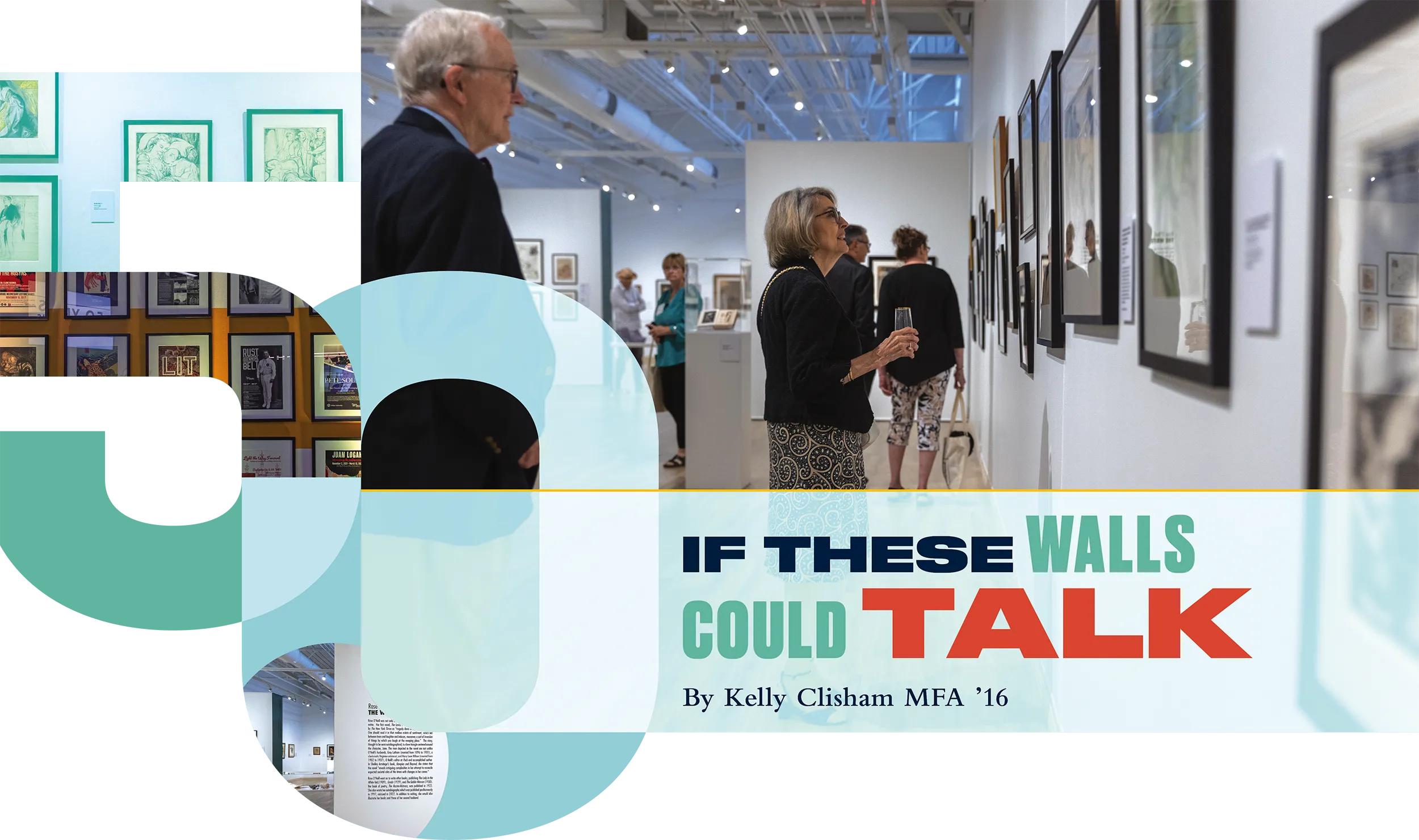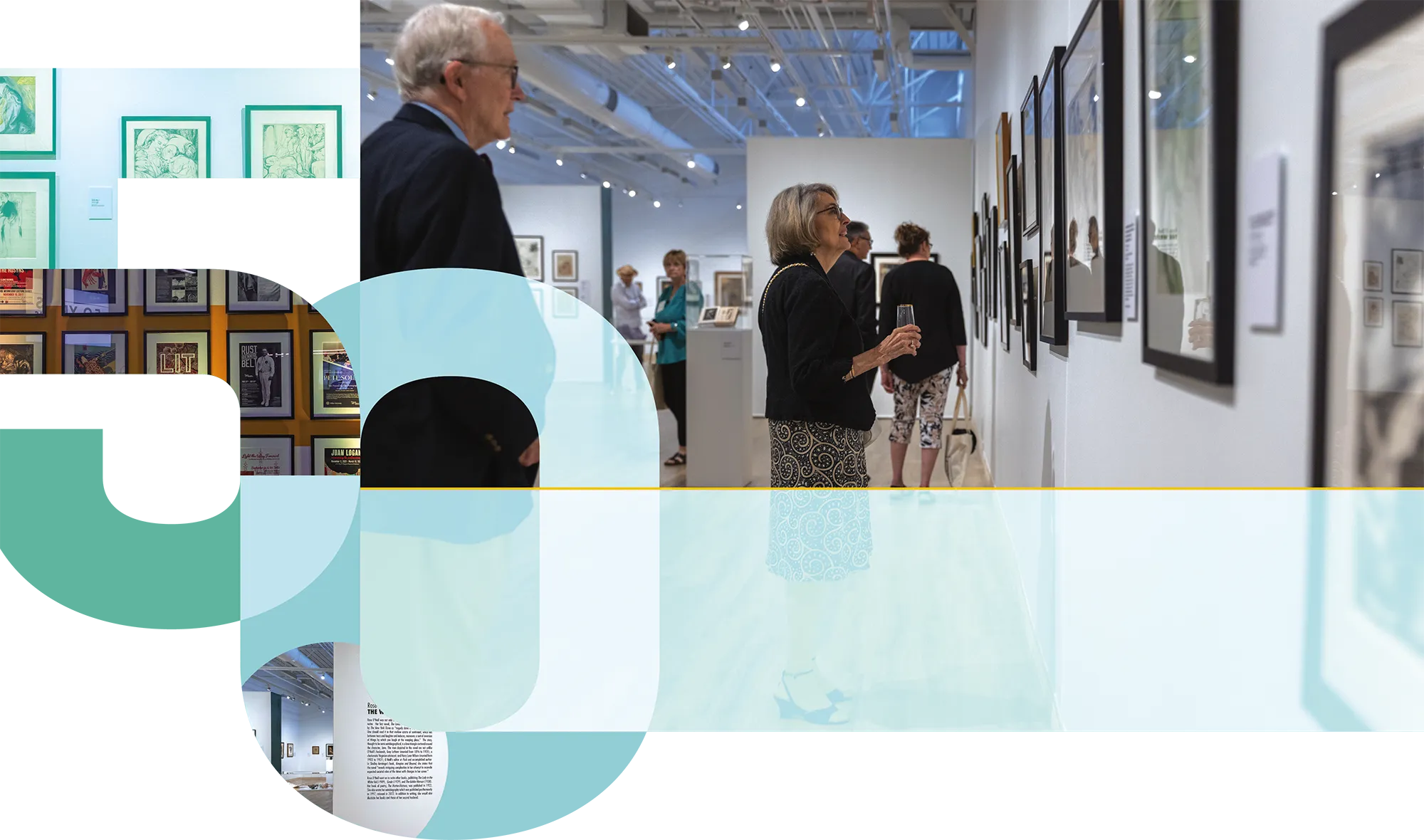If These Walls Could Talk
By Kelly Clisham MFA ’16


If These Walls Could Talk


While the walls can’t talk, the 50-year history of the Sordoni Art Gallery speaks for itself. The gallery opened in 1973 in Stark Hall. The first exhibit, George Catlin: Painter of the Indians of the Americas, featured paintings by the self-taught artist who was born in Wilkes-Barre in 1796. Catlin’s paintings of Native Americans now hang in the Smithsonian.
Heather Sincavage, director of the gallery, still pays tribute to this moment in the gallery’s history. “When I think about programming, every year I want to represent a Pennsylvania-born artist,” said Sincavage. “It’s always been a touchstone and a way to show the professional growth of artists in our state.”
The grand reopening of the gallery in 2017 treated guests to more than 15 minutes with works by Pennsylvania native and pop culture icon Andy Warhol. Andrew J. Sordoni III shared pieces from his collection of American illustration and comic art. Two presidents came to town with Pete Souza, White House photographer for Reagan and Obama.
In just the past 10 years, the gallery has seen significant changes with a move to a larger, more prominent space in the Karambelas Media and Communication Center on South Main Street and the establishment of an endowment to host exhibits by artists of national and international renown.

Virginia Davis has been a staunch supporter since the gallery’s first grand opening in 1973. “I joined as soon as they opened the gallery for membership and I have been a member ever since,” said Davis. As a long-standing member of the advisory commission who served as chair for two separate tenures, she’s helped to guide the Sordoni through five decades of change — and success. “I kept thinking, ‘How can it get any better?’ And it would, and it did,” said Davis.
In an era when art struggles to survive budget cuts and battles a variety of entertainment options for patrons’ interest, the gallery continues to receive the backing of dedicated community members and University leadership. “We do have the love and support of the president,” said Sincavage of President Greg Cant, who was first introduced to the Wilkes community in the gallery. “He attends every event he can.”
Bill Miller ’81, chair of the University’s Board of Trustees, also champions the gallery. Miller serves as president of Galison, a publishing company that helps make art a part of daily life through puzzles, stationery and home décor. “That combination of art and business is what I love about what I do,” said Miller. He also believes exposure to art through the gallery is vital to the Wilkes experience. “It’s part of the bedrock of being educated, being exposed to art and literature,” said Miller. “It’s an integral part of being a university and part of why we’re successful.”
What’s in a Name?
Sordoni’s own love of art was born of legacy. “I’ve been interested in art ever since I was a young kid,” he said. “Three generations of my family collected art.” While the area businessman and philanthropist found his grandfather’s collection of Japanese netsuke and inro appealing, Sordoni drew on his personal taste when he started his own collection of American illustrations and comic art.
A stroll through Sordoni’s Forty Fort office feels like flipping through the Sunday comics, browsing an old magazine and finding a box of pulp paperbacks in the attic. When he purchased his first piece in the early 1960s, part of the draw was affordability. The pieces were often considered trash and some artists didn’t even want to sign their works. For Sordoni, the other part of his attraction to the work was quite literally another story. “They’re narrative,” he said. “They evoke a spirit of adventure, humor, sensationalism, horror.”
Following the death of his father, Andrew J. Sordoni Jr., in 1967, Eugene Farley, president of then Wilkes College, approached the family about a fitting tribute. Sordoni worked with Farley and his mother, the late Margaret Barnard Sordoni, to share the family’s dedication to art with the community. Though the Agnes Flood slowed the process, the Sordoni Art Gallery opened its doors in 1973.
Sordoni shows off framed prints advertising a “Celebration of Music and Art” curated by jazz musician Bob Haggart and a 1976 “Comic Strip Art” exhibit. When he catalogs his gallery experiences, however, he celebrates those colleagues whose dedication has allowed the Sordoni Art Gallery to serve as an exhibitor of fine art in the Wyoming Valley for 50 years, speaking with reverence of former directors Judith O’Toole and Stanley Grand, former Commission chair Virginia Davis, former dean Bob Heaman, and former Wilkes University President Christopher Breiseth.
He acknowledges the change in the gallery’s mission with its transformation from a collecting gallery to one committed to showcasing national and international works courtesy of a permanent, dedicated endowment. Sordoni notes that he may not have a personal connection to every exhibit. “Art can be very esoteric,” he said. “A subject that might interest one person may not interest another.”
Sordoni applauds current director Heather Sincavage for continuing to bring art lovers through the doors with exhibits and programming when so many other things battle for the public’s attention. “Heather has reached areas of the community that we previously had not reached,” he said, hoping for even more growth through continued academic relevance, accessibility, community outreach and support from the University. “The gallery has to continue to certify its mission and earn the support of those who are interested.”
So, what’s in a name? For the Sordoni Art Gallery, it’s a commitment to cultivating art appreciation fueled by decades of passionate directors, volunteers and supporters. For Andrew Sordoni, it’s an adventure, a love story told over a lifetime, that needs to be shared despite distractions and budgets that all too often put art on the chopping block. “Culture is a fundamental part of a civilized society.”

The duo’s teamwork gives the gallery the power to host high-profile exhibits and reach more people in the surrounding area. “We’ve definitely diversified our audience,” said Sincavage. “I think for a while the Sordoni continued because it had a dedicated following, but to see it into the future, we really needed to try to access other audiences. Creating programming and exhibitions that reach many different people allows us to build and grow.”
While visitors are always welcome to stroll through for a casual glance at an exhibit, the Sordoni offers so much more including Cocktails and Culture events, hands-on workshops for Second Saturdays and Art in Context lectures. “The gallery serves an important outreach function for the community, bringing in people from the region and beyond,” said Riggs. “We’re especially proud of the gallery’s success in reaching children through hands-on workshops and other programs.”
Much of this success comes from Carestia’s passion for arts education and outreach, particularly with younger visitors. “Being able to have kids get excited and want to come to the space, that’s one of my favorite things,” said Carestia. Through her career in non-profit development and marketing, she long admired the Sordoni from a distance. These days, she can see the gallery from her desk. “Now, to be part of it is just overwhelming. I’m thankful every day that I get to do programming, that my ideas are received and that I’m appreciated,” said Carestia. “And, I touched an Ansel Adams photograph.”
Wilkes University Alumni Exhibition: Celebrating the Blue and Gold
curator of the Maslow Collection
June 18 – Aug. 11
10 a.m. to 5 p.m. | Tuesdays – Fridays
Noon to 5 p.m. | Saturdays and Sundays
Closed Mondays and University holidays
Karambelas Media & Communication Center



For Wilkes, the gallery provides opportunities for students to utilize art in a variety of disciplines including integrative media and nursing. Moe Woodard, assistant professor of game and emergent technology, collaborates with students to create an augmented reality app that allows users to enhance problem-solving skills through interaction with the gallery’s artwork. Sophomore nursing students who work with Joyce Victor, associate professor of undergraduate nursing, attend grand rounds in the gallery. The process involves observation, discussion, attention to detail and a big picture view — all skills which will help the student nurses feel more comfortable and prepared in the hospital environment.
“It’s a different kind of classroom and it’s a way of understanding their academics in an entirely different way,” said Sincavage. “It’s all an exercise in observation and critical analysis, all things we need. Really, art is a way of understanding our humanity. And we are that resource.”
In addition to innovative academic experience, the Sordoni offers real-world opportunities via work-study jobs and the student design fellow position. Dylan Kofie, a senior digital design and media art major, serves as this year’s fellow and works with curators, artists and a team of student designers. “I help construct meaningful visual identities to accentuate the exhibition at hand and create designs for print and digital assets alike,” said Kofie. “The skills I have honed here at the Sordoni Art Gallery have improved not only my personal development but have fortified my professional know-how.”
As part of the Sordoni since her first year on campus, senior digital design and media art major Erika Tomes appreciates the hands-on design experience and the gallery’s rich history. “It means a lot that I was able to see the 50th anniversary of the gallery. I got to see how everyone’s hard work paid off to display such wonderful art over the years and how I contributed to that,” said Tomes. “It’s a great thing to take a step back and see what has been accomplished throughout my time at Wilkes and what can become of the gallery in the next 50 years.”